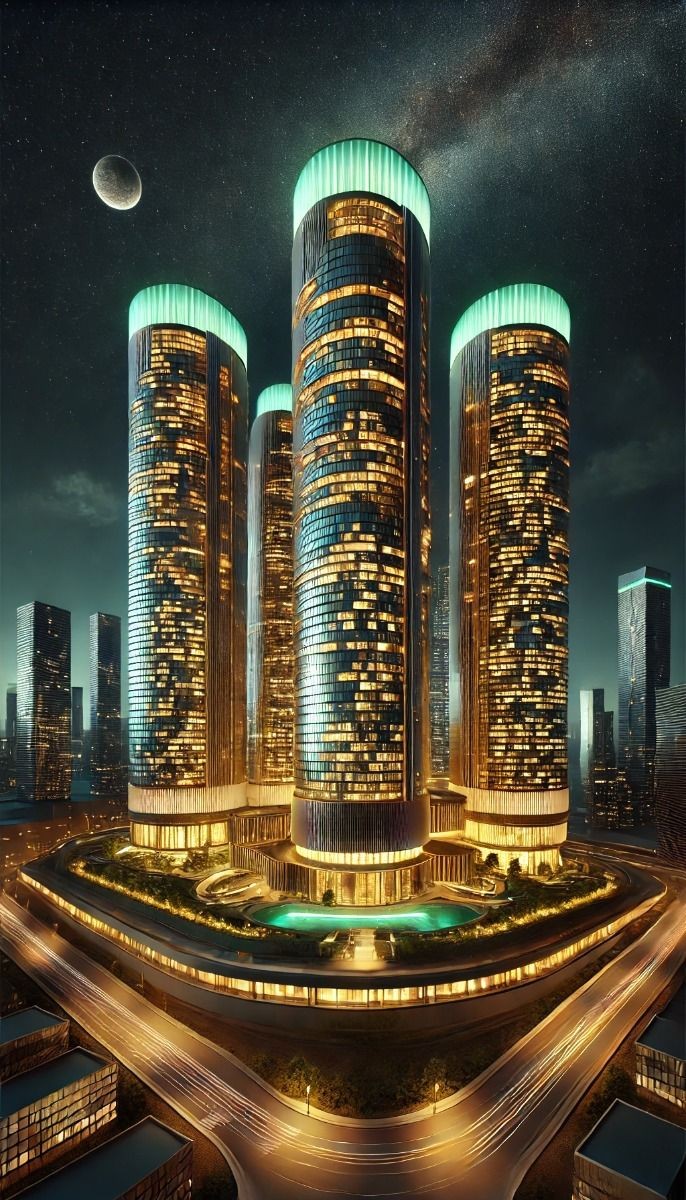

The Rise of Futuristic Skyscraper Design: A New Era in Urban Architecture
As urban landscapes continue to evolve, the architecture of skyscrapers is reaching new heights—literally and figuratively. The image above exemplifies the future of skyscraper design, showcasing a stunning architectural concept that blends cutting-edge technology with visionary aesthetics. This towering structure, with its sleek lines and illuminated features, represents the epitome of modern urban development, pushing the boundaries of how we perceive vertical living and working spaces. In this article, we will delve into the key elements of futuristic skyscraper design, the concept behind this architectural marvel, and how it reflects the future of cityscapes around the globe.
Key Elements of Futuristic Skyscraper Design
1. Sleek, Curved Architecture
The skyscrapers in the image are characterized by their smooth, curved facades, which contrast sharply with the traditional boxy structures that dominate most city skylines. This curved design not only enhances the aesthetic appeal but also improves aerodynamics, reducing wind resistance and making the building more sustainable.
2. Innovative Use of Lighting
One of the most striking features of this skyscraper complex is its innovative lighting. The buildings are crowned with glowing, neon-like caps that give the structure a futuristic aura. This use of lighting serves multiple purposes: it enhances the building’s visibility at night, contributes to the city’s overall ambiance, and symbolizes the forward-thinking nature of the development.
3. Integration of Green Spaces
At the base of the skyscrapers, we see well-integrated green spaces, including landscaped areas and a central pool. These elements are crucial in modern urban design, providing residents and visitors with a touch of nature in an otherwise heavily industrialized setting. The incorporation of green spaces within the structure itself is also indicative of a growing trend in architecture to prioritize sustainability and the well-being of occupants.
4. High-Tech Materials and Construction
Futuristic skyscrapers like the one depicted often rely on advanced materials and construction techniques. From smart glass that adjusts transparency based on sunlight to steel alloys that enhance structural integrity while reducing weight, these buildings are at the forefront of technological innovation. These materials not only improve the building’s performance but also contribute to its sleek, modern appearance.
5. Mixed-Use Development
These skyscrapers are likely designed as mixed-use developments, accommodating both residential and commercial spaces. This approach maximizes the utility of the building and creates a self-sustained environment where people can live, work, and relax without needing to leave the complex. Mixed-use buildings are becoming increasingly popular in urban planning, as they help reduce traffic congestion and create vibrant, 24/7 communities.
The Concept Behind the Design
This skyscraper complex represents the convergence of architectural innovation, sustainability, and urban planning. The design reflects a vision for the future where cities are not just places to live and work, but also hubs of creativity, technology, and environmental stewardship. By incorporating elements like curved architecture, advanced materials, and green spaces, this design aims to set a new standard for what urban development can achieve.
How Futuristic Skyscrapers are Shaping Cityscapes
The trend toward futuristic skyscrapers is reshaping city skylines around the world. These buildings are not just taller but smarter, more sustainable, and more attuned to the needs of modern urban dwellers. As cities continue to grow, the demand for such innovative structures will only increase, driving further advancements in architecture and urban planning.
Conclusion:
Futuristic skyscraper design, as exemplified by the image above, represents the next evolution in urban development. These buildings are more than just feats of engineering; they are symbols of what is possible when technology, design, and sustainability come together. As we look to the future, the rise of such structures will play a pivotal role in shaping the cities of tomorrow, making them more livable, efficient, and inspiring.
